

 At the Spanish and Portugese court,
tobacco was used for a long time as an ornamental plant. It's only in
the mid XVIth century that Philippe II's personal doctor started to
introduce it as a universal medecine to be used to cure colds, asthma
and circulatory disorders just to name a few.
Tobacco arrived in France around 1556.
The story tells that it might be André THEVET (1524-1592), a
monk from the Angoumois region, of the expedition of "de
Villegagnon", coming back from Brazil, who brought back a bag full of
seeds and sowed them in his native land.
The large veined leaf was first of all
smoked in a pipe and then taken powdered from a grater.
Snuff tabacco owed its success thanks to
its introduction to Catherine de MEDICIS (1519-1589), Queen of France
during the reign of Henri II, whose son Charles IX (1550-1574) was
suffering from severe migraines and that no doctor had managed to
cure.
Catherine de Médicis and
her son Charles IX
Jean NICOT (1530-1600) then Ambassador of
France in Portugal where he had discovered the healing properties of
tabacco introduced it at the French court and recommended this remedy
to the young prince. After a few powder tabacco takes his migraines
alleviated.
At the Spanish and Portugese court,
tobacco was used for a long time as an ornamental plant. It's only in
the mid XVIth century that Philippe II's personal doctor started to
introduce it as a universal medecine to be used to cure colds, asthma
and circulatory disorders just to name a few.
Tobacco arrived in France around 1556.
The story tells that it might be André THEVET (1524-1592), a
monk from the Angoumois region, of the expedition of "de
Villegagnon", coming back from Brazil, who brought back a bag full of
seeds and sowed them in his native land.
The large veined leaf was first of all
smoked in a pipe and then taken powdered from a grater.
Snuff tabacco owed its success thanks to
its introduction to Catherine de MEDICIS (1519-1589), Queen of France
during the reign of Henri II, whose son Charles IX (1550-1574) was
suffering from severe migraines and that no doctor had managed to
cure.
Catherine de Médicis and
her son Charles IX
Jean NICOT (1530-1600) then Ambassador of
France in Portugal where he had discovered the healing properties of
tabacco introduced it at the French court and recommended this remedy
to the young prince. After a few powder tabacco takes his migraines
alleviated.
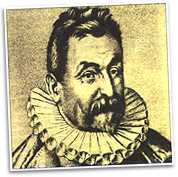 *
*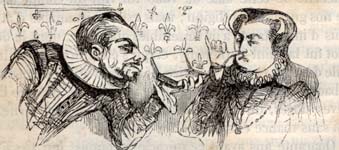 Jean NICOT / NICOT offering a
pinch of snuff to Catherine de Medicis
Jean NICOT / NICOT offering a
pinch of snuff to Catherine de Medicis
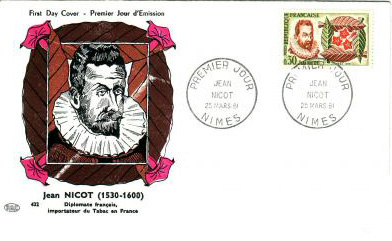 Envelope First Day Cover Jean
NICOT
March 25th 1961, Nimes /
FRANCE
The treatment was a real success. The
Queen favoured its promotion in the whole court and the entire court
started to snuff. It was first and only sold at apothecaries under
various names such as : "Herbe à la reine",
"Cathérinaire", "Médicée", "Herbe à
Nicot", "Herbe à l'Ambassadeur"...
As a tribute to Jean NICOT, botanists
named this tabacco plant : "Nicotiana tabacum".
Later on, its sneezing properties and the
pleasantness enjoyed through inhaling a scented powder which could
prevent from breathing the rather disgraceful odours of the streets
of that time, made it fashionable throughtout the kingdom. Scented
oils or herbs were often added to the tobacco in order to refine its
taste.
Snuff tabacco, rather exotic, was mainly
reserved to refined aristocratic and bourgeois nostrils while chewing
tabacco could only be used by peasants' mouths.
Pleople started to snuff in the first
place to cure diseases and then for pleasure.
Snuffing tabacco spread widely throughout
Europe and in European parlours it was common to be interupted in
one's conversation by the sound of a sneezing then considered as
distinguished. Women snuffed as fervently as men . It was good
manners to change snuff boxes every day and they were meant to be
adapted to the clothes or spririt of their owners. Taken from a
pocket or a small bag, in parlours, they were passed round from hand
to hand which enabled to determine the social status and wealth of
their owners.
Envelope First Day Cover Jean
NICOT
March 25th 1961, Nimes /
FRANCE
The treatment was a real success. The
Queen favoured its promotion in the whole court and the entire court
started to snuff. It was first and only sold at apothecaries under
various names such as : "Herbe à la reine",
"Cathérinaire", "Médicée", "Herbe à
Nicot", "Herbe à l'Ambassadeur"...
As a tribute to Jean NICOT, botanists
named this tabacco plant : "Nicotiana tabacum".
Later on, its sneezing properties and the
pleasantness enjoyed through inhaling a scented powder which could
prevent from breathing the rather disgraceful odours of the streets
of that time, made it fashionable throughtout the kingdom. Scented
oils or herbs were often added to the tobacco in order to refine its
taste.
Snuff tabacco, rather exotic, was mainly
reserved to refined aristocratic and bourgeois nostrils while chewing
tabacco could only be used by peasants' mouths.
Pleople started to snuff in the first
place to cure diseases and then for pleasure.
Snuffing tabacco spread widely throughout
Europe and in European parlours it was common to be interupted in
one's conversation by the sound of a sneezing then considered as
distinguished. Women snuffed as fervently as men . It was good
manners to change snuff boxes every day and they were meant to be
adapted to the clothes or spririt of their owners. Taken from a
pocket or a small bag, in parlours, they were passed round from hand
to hand which enabled to determine the social status and wealth of
their owners.
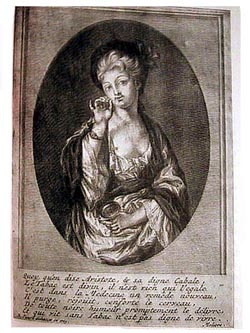 Therefore, snuff boxes, often decorated,
became the latest fashionable accessory but also an important symbol
of social status.
As such, the snuff box was often offered
as a present or carried as a piece of jewellery.
It was offered as a token of one's love
with the portrait of the loved one or to prove one's friendship.
Therefore, snuff boxes, often decorated,
became the latest fashionable accessory but also an important symbol
of social status.
As such, the snuff box was often offered
as a present or carried as a piece of jewellery.
It was offered as a token of one's love
with the portrait of the loved one or to prove one's friendship.
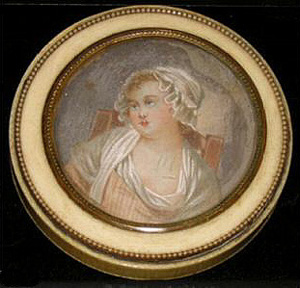 Precious models, made of silver or
decorated with precious stones were usually offered as a diplomatic
or military present.
Louis XIV, who wasn't a snuff taker
himself used to have some costly ones made especially in order to
offer them to foreign diplomats whom he encountered.
Snuff boxes were therefore mostly made
using gold with precious stones, silver, enamel, mother of pearl,
oriental lacquer and vernis Martin ( french imitation of
lacquer)
Precious models, made of silver or
decorated with precious stones were usually offered as a diplomatic
or military present.
Louis XIV, who wasn't a snuff taker
himself used to have some costly ones made especially in order to
offer them to foreign diplomats whom he encountered.
Snuff boxes were therefore mostly made
using gold with precious stones, silver, enamel, mother of pearl,
oriental lacquer and vernis Martin ( french imitation of
lacquer)
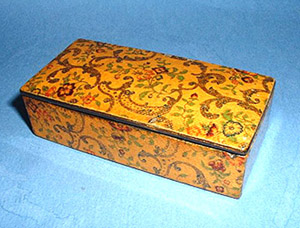 Vernis Martin
With time and the increase in its
production (snuff tabacco made in MORLAIX was well appreciated),
tobacco became more and more popular and finally reached every rank
of our society.
So, during the French revolution, snuff
boxes weren't only reserved to richmen but -tobacco being now a
popular product- to everybody . As a matter of fact, the Republic
welcomed the snuff box as an official present. The snuff box also
became a rallying symbol of the "sans culottes" and was greatly used
by the army.
Vernis Martin
With time and the increase in its
production (snuff tabacco made in MORLAIX was well appreciated),
tobacco became more and more popular and finally reached every rank
of our society.
So, during the French revolution, snuff
boxes weren't only reserved to richmen but -tobacco being now a
popular product- to everybody . As a matter of fact, the Republic
welcomed the snuff box as an official present. The snuff box also
became a rallying symbol of the "sans culottes" and was greatly used
by the army.
 *
*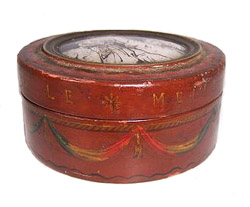 Sarcastic revolutionnary snuff
box made of wood with vernis Martin and depicting
a "sans-culotte" covering Louis
the XVIth with the phrygian's hat.
Sarcastic revolutionnary snuff
box made of wood with vernis Martin and depicting
a "sans-culotte" covering Louis
the XVIth with the phrygian's hat.
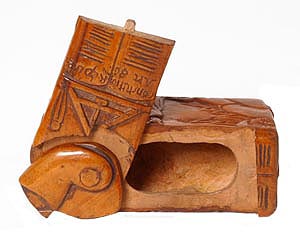 Revolutionnary snuff box from the
Pompidou centre/ Paris
Copyright
Revolutionnary snuff box from the
Pompidou centre/ Paris
Copyright
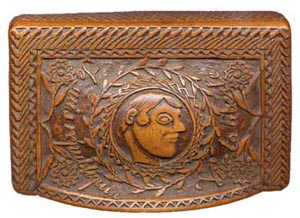 Republican snuff box
Then, Gold was replaced by "pompronne" (a
less costly gold plated) :
Republican snuff box
Then, Gold was replaced by "pompronne" (a
less costly gold plated) :
 Pompronne
...and new materials appeared: papier
mâché, leather, bark... The waitress, the washer-woman
and the poorest of peasants all carried a snuff box in their
smock.
Pompronne
...and new materials appeared: papier
mâché, leather, bark... The waitress, the washer-woman
and the poorest of peasants all carried a snuff box in their
smock.
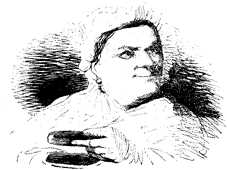 Sold only at apothicaries', tobacco
started to show behind grocery counters before joining gambling clubs
and pubs then called : "tabagies" .
Numerous shapes and sizes are available,
either for the pocket or to be left on the table in living rooms,
according to their use indoors or outdoors.
The pocket snuff box must be flat and of
a small size in order to be able to easily find a tiny space in the
pocket. Its shape must be made in such a way that it stays
horizontally in the hand, with an opening large enough to enable a
pinch of tabacco from two fingers, not too large to avoid the powder
from flying away. Finally, its clasp must be perfectly air/watertight
and its hinge must be made in such a way that tobacco can't penetrate
inside.
Some users, such as sailors preferred the
snuff boxes called "secouettes" (shakers). They are characterized by
the fact that (unlike the classic snuff box) they don't carry lids
but at least one hole . French sailors mainly from Britany (Bretons),
used terracota "secouettes". Their manufacturing is related to the
city of Quimper :
Sold only at apothicaries', tobacco
started to show behind grocery counters before joining gambling clubs
and pubs then called : "tabagies" .
Numerous shapes and sizes are available,
either for the pocket or to be left on the table in living rooms,
according to their use indoors or outdoors.
The pocket snuff box must be flat and of
a small size in order to be able to easily find a tiny space in the
pocket. Its shape must be made in such a way that it stays
horizontally in the hand, with an opening large enough to enable a
pinch of tabacco from two fingers, not too large to avoid the powder
from flying away. Finally, its clasp must be perfectly air/watertight
and its hinge must be made in such a way that tobacco can't penetrate
inside.
Some users, such as sailors preferred the
snuff boxes called "secouettes" (shakers). They are characterized by
the fact that (unlike the classic snuff box) they don't carry lids
but at least one hole . French sailors mainly from Britany (Bretons),
used terracota "secouettes". Their manufacturing is related to the
city of Quimper :
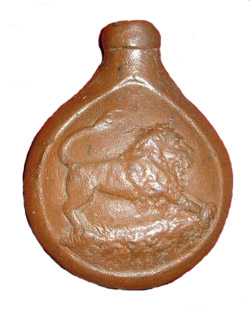 Beautiful Quimper made snuff box
/ secouette with the drawing of a lion.
Beautiful Quimper made snuff box
/ secouette with the drawing of a lion.






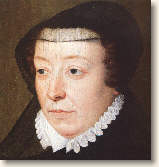

 *
*





